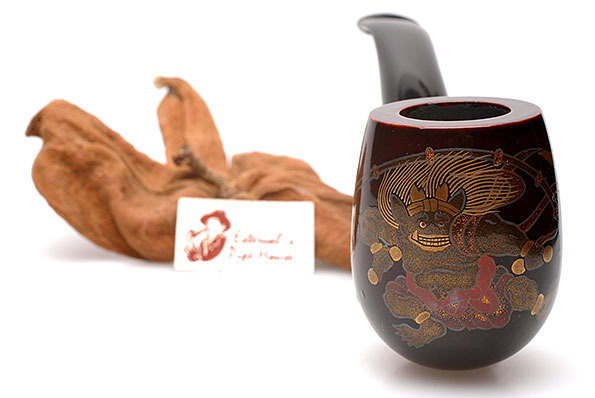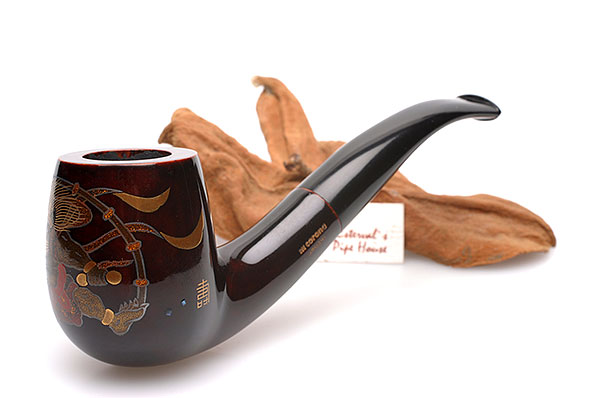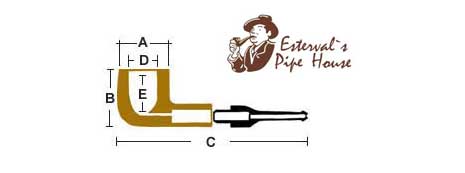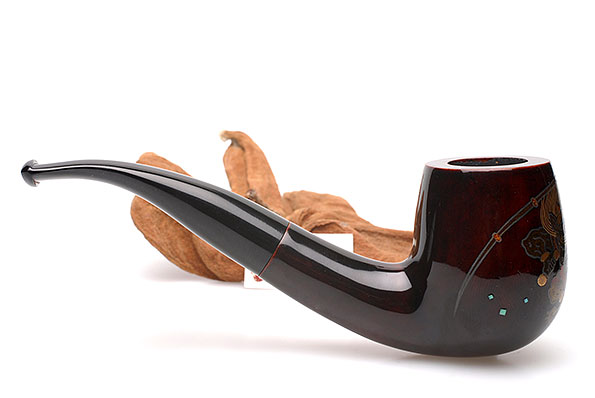| Hersteller: |
IM Corona
|
| Modellbezeichnung: |
Urushi
Japan Lack
|
| Made in: |
Japan
|
| Shape: |
Bent
|
| Typ: |
Einzelstück
|
| Pfeifenkopf: |
Bruyere
|
| Mundstück: |
Kautschuk
Fish-tail
Wide-bore
|
| Bohrung: |
3,6mm
|
| Applikation: |
-
|
| Zustand: |
Neuware
|
Urushi (japanisch) ist eine Lackierungstechnik und ein altes japanisches Kunsthandwerk. Die Wurzel dieser Technik lassen sich ca. 6000 Jahre zurückverfolgen. Zuerst dient das Harz der Befestigung von Speer- und Pfeilspitzen. Im 6. Jahrhundert erreichte die Urushi Technik ein hohes künstlerisches Niveau und war über Jahrzehnte als Luxusgut dem Kaiserhaus und dem Adel vorbehalten.

Der Rohstoff dafür wird aus dem Harz des mit Essigbaum verwandten ostasiatischen Lackbaumes (Rhus vernicifera, jap. No Ki) gewonnen. Das Harz ist klar und sehr hell bis dunkel bernsteinfarben.
Als Grundlage werden meist Holz- oder Papiermaché- Gegenstände verwendet, die zuerst mit einer Paste aus Urushi und Tonpulver grundiert und mit einem Wasserstein oder Schleifpapier naß geschliffen werden. Dann wird in zahlreichen Schichten farbiges Urushi aufgetragen. Urushi wird traditionell oft rot (mit Eisenoxid und Zinnober) oder schwarz (Ruß) pigmentiert, kann aber auch als Klarlack verarbeitet werden.
Teilweise wird in dem Lack noch anderes Material eingebettet, z.B. Gold- oder Silberstaub oder Blattmetall, Perlmut und sogar Eierschalen. Jede Schicht muß unter absolut staubfreien Bedingungen im Wasserdampf aushärten. Die Lackierung hat einen Glanz und eine Tiefe, die weder durch Schellackpolitur noch durch moderne Kunstharzlacke erreicht werden kann.
Gegenstände wie Schalen, Eßstäbchen, Tabletts, Möbel aber auch Kyudo-Bögen und die Scheiden japanischer Schwerter werden damit lackiert. Und natürlich Pfeifen.


Angaben ca.
|
A
|
4,0 cm
|
1.58 inch
|
|
B
|
5,1 cm
|
2.01 inch
|
|
C
|
14,0 cm
|
5.51 inch
|
|
D
|
2,0 cm
|
0.79 inch
|
|
E
|
4,1 cm
|
1.61 inch
|
|
Gewicht
|
54 gramm
|
54 gram
|




